

详解原型与原型链
source link: https://www.clzczh.top/2022/03/16/javascript-prototype/
Go to the source link to view the article. You can view the picture content, updated content and better typesetting reading experience. If the link is broken, please click the button below to view the snapshot at that time.

详解原型与原型链
其实,刚开始学 JavaScript 时,就有学过原型与原型链的相关知识了,只是当时还没有养成写笔记的习惯,导致现在已经忘的七七八八了。
这边文章真是花了很多心思,写了两天,看了很多篇篇博文,其中有小参考的,有解决一点疑惑的,但是最后只标注了一篇帮助最大的。
实例的构造函数属性( constructor)指向其构造函数
function Person(name) {
this.name = name;
}
const person = new Person("clz");
console.log(person.constructor === Person); // true
实例的构造函数并不是自身属性,而是从原型对象上继承的属性
function Person(name) {
this.name = name;
}
const person = new Person("clz");
console.log(person.constructor === Person); // true
console.log(Person.prototype.constructor === Person); // true
console.log(person.hasOwnProperty("constructor")); // false:constructor属性并不是实例自身的属性,而是继承来的
__proto__(隐式原型):每个对象(除了null)都具有的属性,该属性指向该对象的原型prototype(显式原型):只有函数对象才有的属性,该属性指向函数的原型对象
const arr = [1, 2, 3];
const obj = {
name: "clz",
};
function add(a, b) {
return a + b;
}
console.log(arr);
console.log(obj);
console.log(add);
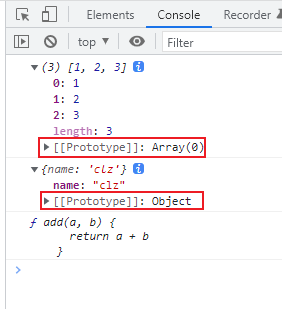
红框框中的 [[prototype]]和 __proto__意义相同,都是指对象的内部属性
而所有函数都拥有 prototype属性,所以可以通过 f.prototype得到,那么自然也不需要通过 [[prototype]]显示出来(毕竟 prototype是显式原型,而 __proto__是隐式原型,好吧,这是我猜的)
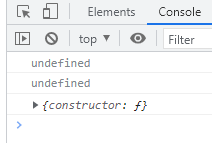
箭头函数没有 prototype属性
通过实例对象访问原型对象有 3 种方法
obj.__proto__obj.constructor.prototypeObject.getPrototypeOf(obj)
function Person(name) {
this.name = name;
}
const person = new Person("clz");
const proto1 = person.__proto__;
const proto2 = person.constructor.prototype;
const proto3 = Object.getPrototypeOf(person);
const proto = Person.prototype; // 原型
console.log(proto1 === proto); // true: 第一种方法
console.log(proto2 === proto); // true: 第二种方法
console.log(proto3 === proto); // true: 第三种方法
比较安全的做法是Object.getPrototypeOf(obj)
以下部分会涉及一丢丢原型链的知识(如果没看懂,可以看下原型链再来看)
__proto__属性是私有属性,存在浏览器兼容性问题,缺乏非浏览器环境的支持如果 obj 的
constructor属性被覆盖,那么obj.constructor.prototype将会失效。(因为 obj 自身是没有constructor属性的,是通过原型链去它的原型上获取constructor属性,所以覆盖该属性时,将不会再去原型链上查找)function Person(name) { this.name = name; } function Temp(name) { this.name = name; } const person = new Person("clz"); person.constructor = Temp; const proto = Person.prototype; // 原型 console.log(person.__proto__ === proto); // true: 第一种方法 console.log(person.constructor.prototype === proto); // false: 第二种方法 console.log(Object.getPrototypeOf(person) === proto); // true: 第三种方法
设置原型对象有 3 种方法
obj.__proto__=prototypeObjObject.setPrototypeOf(obj, prototypeObj)Object.create(prototypeObj)
const proto = {
// 原型对象
name: "prototype",
};
// 第一种方法
const obj1 = {};
obj1.__proto__ = proto; // 设置原型
console.log(obj1.name); // prototype
console.log(obj1.__proto__ === proto); // true
// 第二种方法
const obj2 = {};
Object.setPrototypeOf(obj2, proto); // 设置原型
console.log(obj2.name); // prototype
console.log(obj2.__proto__ === proto); // true
// 第三种方法
const obj3 = Object.create(proto); // 创建对象并设置原型
console.log(obj3.name); // prototype
console.log(obj3.__proto__ === proto); // true
使用 obj1.isPrototypeOf(obj2)方法判断 obj1是否为· obj2的原型
const proto = {
// 原型对象
name: "prototype",
};
const proto1 = {
name: "prototype",
};
const obj = {};
obj.__proto__ = proto; // 设置原型
console.log(proto.isPrototypeOf(obj)); // true
console.log(Object.prototype.isPrototypeOf(obj)); // true
console.log(proto1.isPrototypeOf(obj)); // false
prototype、__proto__、constructor 之间的关系
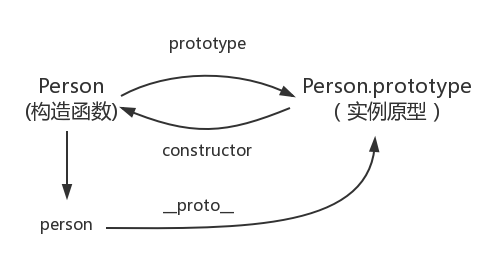
function Person(name) {
this.name = name;
}
const person = new Person("clz");
console.log(person.__proto__ === Person.prototype); // true:因为创建person对象的构造函数是Person,所以person对象的隐式原型(__proto__)指向Person函数的原型(prototype)
console.log(Person.prototype.constructor === Person); // true
同一个构造函数创建的多个实例的原型是同一个
function Person(name) {
this.name = name;
}
const person1 = new Person("clz");
const person2 = new Person("clz");
console.log(person1 === person2); // false: 不是同一个对象
console.log(person1.__proto__ === person2.__proto__); // true:同一个构造函数创建的实例对象的原型是同一个
由上面的知识可以知道,实例对象具有属性 __proto__,会指向原型对象。而原型对象也是对象,所以也会有属性 __proto__,也会继续指向它的原型对象。
实例对象在查找属性时,如果查找不到,就会沿着 __proto__去它的原型上查找,还找不到,则继续去原型的原型上查找,直到找到或到最顶层为止。这就是原型链的概念。
对象本身的方法(第一层:把方法当成属性)
function Person(name) {
this.name = name;
this.listenMusic = function () {
console.log("听音乐");
};
}
const person = new Person("clz");
console.log(person);
console.log(
"实例对象本身是否有listenMusic方法",
person.hasOwnProperty("listenMusic")
);
person.listenMusic();
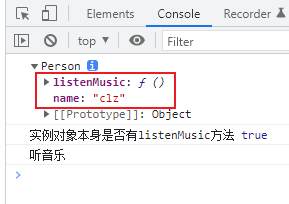
对象的原型上添加方法(第二层)
function Person(name) {
this.name = name;
}
Person.prototype.listenMusic = function () {
console.log("听音乐");
};
const person = new Person("clz");
console.log(person);
console.log(
"实例对象本身是否有listenMusic方法",
person.hasOwnProperty("listenMusic")
);
person.listenMusic();
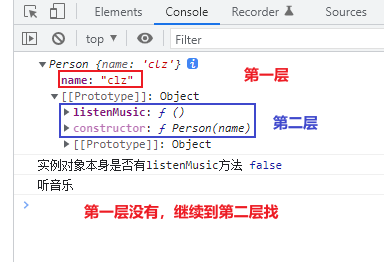
原型的原型上的方法(第三层)
function Person(name) {
this.name = name;
}
Person.prototype.__proto__.listenMusic = function () {
console.log("听音乐");
};
const person = new Person("clz");
console.log(person);
person.listenMusic();
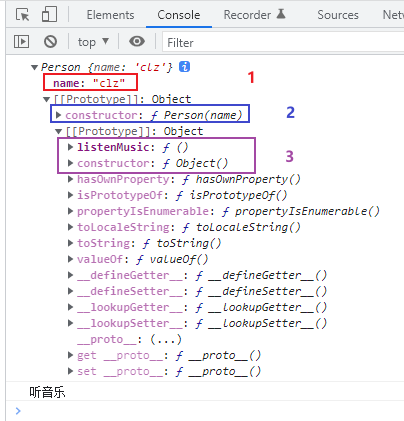
但是呢,没法玩第四层,因为已经到顶了( Object.prototype没有原型(原型为 null))
function Person(name) {
this.name = name;
}
Person.prototype.__proto__.__proto__.listenMusic = function () {
console.log("听音乐");
};
const person = new Person("clz");
console.log(person);
person.listenMusic();

person -> Person.prototype -> Object.prototype -> null
那么,这里就来看看第三层是不是真的是 Object.prototype
function Person(name) {
this.name = name;
}
Person.prototype.__proto__.listenMusic = function () {
console.log("听音乐");
};
const person = new Person("clz");
console.log(person);
console.log(Person.prototype.__proto__ === person.__proto__.__proto__);
console.log(person.__proto__.__proto__ === Object.prototype); // 这里就是判断处
person.listenMusic();
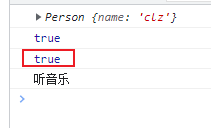
发现,确实如此。
下面这张图就是原型链的简单图(找不到是在哪里截的图了,侵删)
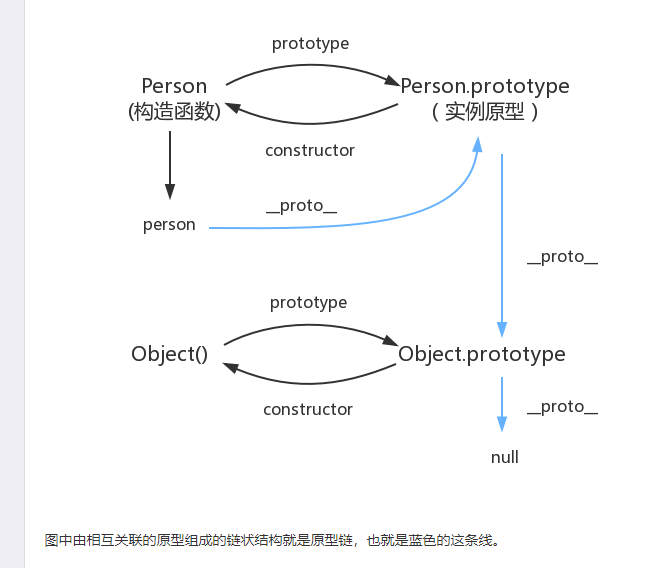
原型链的作用
为对象设置默认值
利用原型为对象设置默认值。当原型属性与私有属性同名时,删除私有属性之后,可以访问原型属性,即可以把原型属性值作为初始化默认值。
function Person(name) {
this.name = name;
}
Person.prototype.name = "赤蓝紫";
const person = new Person("clz");
console.log(person.name); // clz
delete person.name;
console.log(person.name); // 赤蓝紫
继承内容部分之后单独写。
扩展原型方法
Array.prototype.test = function () {
console.log("扩展原型方法: 有风险");
};
const arr = [1, 2, 3];
arr.test(); // 扩展原型方法: 有风险
typeof
typeof 是判断类型时大多数人的选择(当然也包括我啦),但是,判断非基本数据类型(function除外)时,只能得到 Object。(null 也是,但是 null 这个属于是历史遗留 bug 了)。
js 在底层存储变量的时候,会在变量的机器码的低位 1-3 位存储其类型信息
- 000:对象
- 010:浮点数
- 100:字符串
- 110:布尔
null:所有机器码均为 0
undefined:用 −2^30 整数来表示
symbol和 bigint是后来新增的数据类型
const num = 123;
const str = "hello";
const bool = true;
const n = null;
const u = undefined;
const sym = Symbol(1);
const big = BigInt(123);
const fun = () => console.log(1);
console.log(typeof num); // number
console.log(typeof str); // string
console.log(typeof bool); // boolean
console.log(typeof n); // object
console.log(typeof u); // undefined
console.log(typeof sym); // symbol
console.log(typeof big); //bigint
console.log(typeof fun); //function
function除外的非基本数据类型
let arr = [];
let obj = {
name: "clz",
};
let set = new Set([1, 2, 4]);
console.log(typeof arr);
console.log(typeof obj);
console.log(typeof set);
清一色 object
通过Object.prototype.toString.call(obj)来识别对象类型。会返回"[object Type]"来告诉你所指对象的类型
let arr = []
let obj = {
name: 'clz'
}
let set = new Set([1, 2, 4])
console.log(Object.prototype.toString.call(arr)) // [object Array]
console.log(Object.prototype.toString.call(obj)) // [object Object]
console.log(Object.prototype.toString.call(set)) // [object Set]
instanceof
instanceof只要右边变量的 prototype 在左边变量的原型链上,就会返回true
function Person(name) {
this.name = name;
}
function Test(name) {
this.name = name;
}
const person = new Person("clz");
console.log(person instanceof Person); // true
console.log(person instanceof Object); // true
console.log(person instanceof Test); // false
普通对象与函数对象
所有的函数都是通过
new Function()来创建的,即是函数对象**其他的都是普通对象 **
function fn1() {}
const fn2 = function () {};
const fn3 = () => {};
const fn4 = new Function();
console.log(typeof fn1); //function
console.log(typeof fn2); //function
console.log(typeof fn3); //function
console.log(typeof fn4); //function
const obj1 = {};
const obj2 = new Object();
const obj3 = new fn1();
console.log(typeof obj1); //object
console.log(typeof obj2); //object
console.log(typeof obj3); //object
上面的例子中, fn1、 fn2、 fn3、 fn4是函数对象, obj1、 obj2、 obj3是普通对象
- Object 是构造函数,即也是函数,所以
Object也是函数对象,相当于Function的实例,即Object.__proto__ === Function.prototypeObject.prototype是Object构造函数的原型,处于原型链的顶端,Object.prototype.__proto__已经没有可以指向的上层原型,因此其值为null
console.log(typeof Object); // function
console.log(Object.__proto__ === Function.prototype); // true
console.log(Object.prototype.__proto__); // null
Function.prototype是Function的原型,是所有函数对象的原型Function.prototype是一个普通对象,所以Function.prototype.__proto__ === Object.prototypeFunction函数不通过任何东西创建,JS引擎启动时,添加到内存中,所以**Function.__proto__ === Function.prototype**
console.log(typeof Function); // function
console.log(Function.prototype.__proto__ === Object.prototype); // true
console.log(Function.__proto__ === Function.prototype); // true
经典原型链图
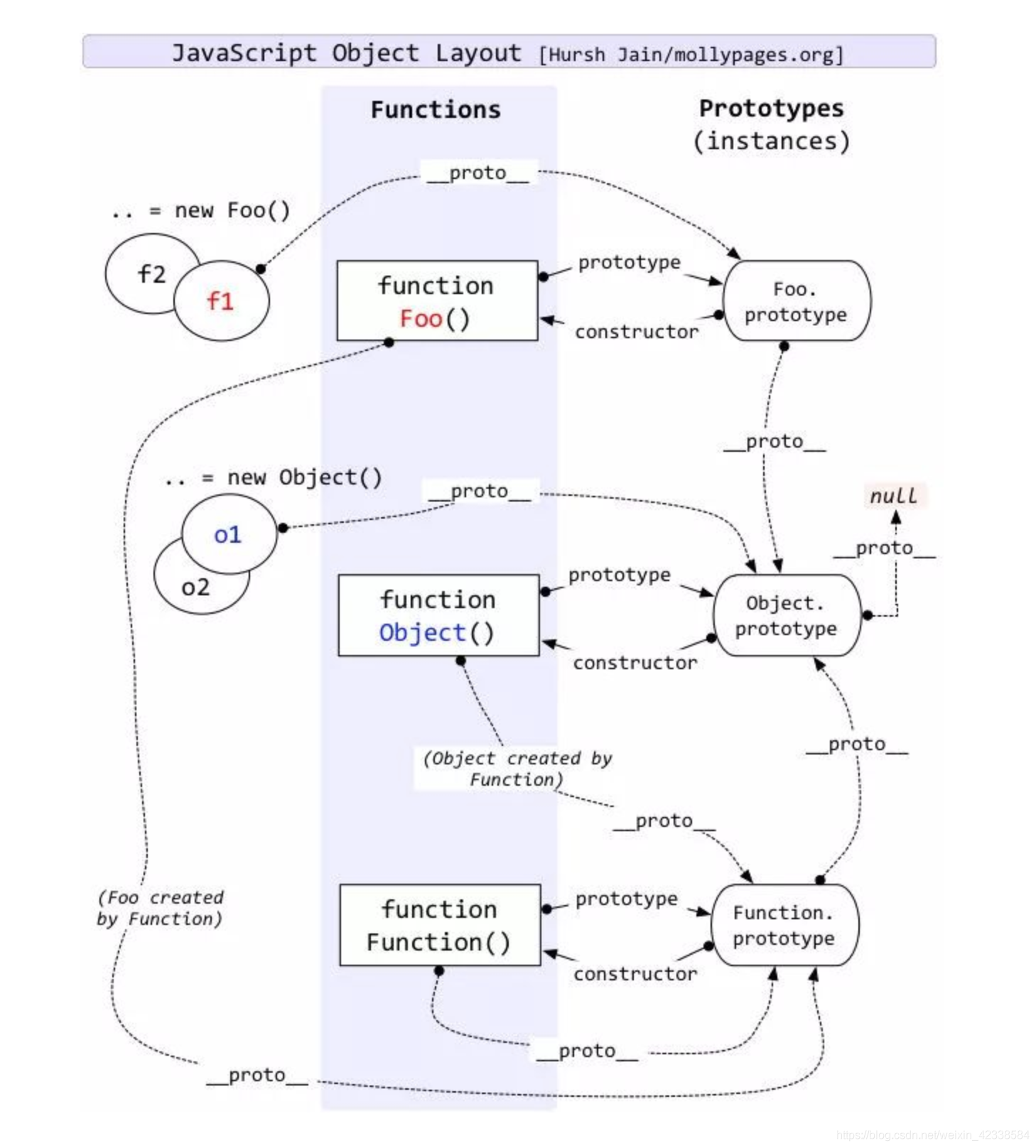
function User() {}
User.prototype.sayHello = function () {};
var u1 = new User();
var u2 = new User();
console.log(u1.sayHello === u2.sayHello);
console.log(User.prototype.constructor);
console.log(User.prototype === Function.prototype);
console.log(User.prototype.__proto__ === Function.prototype.__proto__);
console.log(User.prototype === u1.__proto__);
console.log(User.__proto__ === Function.prototype);
console.log(User.__proto__ === Function.__proto__);
console.log(u1.__proto__ === u2.__proto__);
console.log(u1.__proto__ === User.__proto__);
console.log(Function.__proto__ === Object.__proto__);
console.log(Function.prototype.__proto__ === Object.prototype.__proto__);
console.log(Function.prototype.__proto__ === Object.prototype);
校对答案:(可能有点难,细嚼慢咽后再反复看就行)
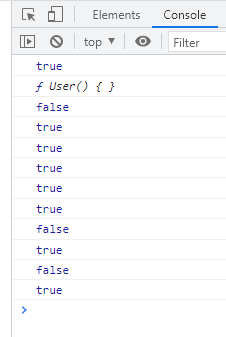
Recommend
About Joyk
Aggregate valuable and interesting links.
Joyk means Joy of geeK